Kent
Explore hidden histories, historic photos, and things you never knew about Kent from the collections and archives of Historic England.
Discover your local listed buildings and places
Introducing some of Kent's most historic sites, included in the National Heritage List for England. Some of these captions have been summarised by AI. Click through for the official List entry. Skip this section and go to place by numbers
Finnish Olympic Sauna
Ditton
A prefabricated timber sauna manufactured by Finnish company Puutalo Oy (Timber Houses Limited) for the 1948 London Olympic Games.
Dreamland Cinema
Margate
Dreamland Cinema in Margate, completed in 1935, is an exceptional early example of the influence of German cinema design in England, showcasing multiple architectural styles.
Sandgate Castle
Sandgate
Sandgate Castle, built by Henry VIII, is a Tudor artillery fortress and Martello tower. It uniquely protected Kent's beach and coast road rather than a harbour.
Dover Castle
Dover
Dover Castle features a Norman keep built around 1155. Surrounded by 18th-century houses and fortified medieval walls, it includes subterranean passages enhanced in the Napoleonic period.
Gun Wharf, Dock Road, Chatham
Chatham
Gun Wharf was designed by Arup Associates and was built in 1976-8 for Lloyd's of London as their administrative headquarters.
Royal Victoria Pavilion
Ramsgate
Seaside pavilion of 1903, by Stanley Davenport Adshead, originally incorporating a theatre and cafe, later converted to a casino and then to a public house in 2018.
Statue of Princess Pocahontas in the Churchyard of the Ch…
Gravesend
A C20 life-sized bronze statue of the Native American Princess Pocahontas, of 1957, cast from the original by WA Partridge. Read the official list entry to find out more.
Waldershare Park
Eythorne
Waldershare Park features an early 18th-century formal layout. The estate, acquired by Sir Henry Furness in 1705, includes notable architectural contributions by William Talman.
The Gate House
Dover
Gate lodge. Built in 1850 in Gothic style. The C20 north extension is not of special interest.
Calverley Park and Calverley Grounds
Royal Tunbridge Wells
Calverley Park, developed in the 19th century by Decimus Burton, features villas and parklands in Tunbridge Wells. It includes both private gardens and a public park.
Granville House (the former Granville Hotel)
Ramsgate
A terrace turned hotel built 1867-1869 to the designs of E W Pugin, with a series of later additions and alterations. Read the official list entry to find out more.
The archbishop's palace
Charing
Charing Palace, an archiepiscopal manor house, is a nationally significant high-status residence from the medieval period, noted for its preserved architecture and historical records.
East Court
Ramsgate
A large villa designed by Ernest George and Harold Peto in 1889-1890 for Sir William Wills (later Lord Winterstoke). Read the official list entry to find out more.
Large multivallate hillfort and Palaeolithic rock shelter…
Ightham
Oldbury Hill hosts a rare large Iron Age hillfort and Palaeolithic rock shelters, highlighting human activity and social organization from ancient times.
Parish Church of St John the Baptist
Margate
A complex, multi-phase church. Part of the N aisle and the chancel arcades are mid C12, and the rest of the N aisle and the S aisle were added in the late C12 or early C13.
Canterbury Cathedral, St. Augustine's Abbey and St. Marti…
Canterbury
The official listing for all World Heritage sites is held by UNESCO and can be found on their website.
Phoenix Caisson off Littlestone-on-Sea
Situated in the Straits of Dover, off Littlestone-on-Sea, Kent, approximately 0.66 km from the low water mark, at NGR TR0949324640.
Phoenix caisson. Built in 1943-4 as part of the 'Mulberry' floating harbour. Read the official list entry to find out more.
Radar Station Receiver Site, Including the Receiver Build…
Ivychurch
Rye Radar Station Receiver Site, including the receiver building, receiver mast bases and a Light Anti-aircraft gun site, built probably early 1939 and certainly operational by September...
Former Military Hospital
Sheerness
A former military hospital. Work on the hospital commenced in June 1856 and it was opened in October 1857.
Dover Town Hall, including the remains of the medieval Ma…
Dover
Town hall, including the remains of the medieval Maison Dieu.
Redleaf
Chiddingstone
Redleaf estate, developed by William Wells, featured intricate gardens and grounds known for their scenic views and rich plantings, surviving in parts through private ownership.
Former Tilling-Stevens Factory
Maidstone
This former motor vehicle factory was built in 1917 by Wallis, Gilbert and Partners, in collaboration with Truscon, for Tilling-Stevens Ltd.
Folkestone Harbour Viaduct and Swing Bridge
Folkestone
Folkestone Harbour viaduct was built in 1843 by the South Eastern Railway Company, and was designed by William Cubitt, Chief Engineer of the line.
Otford Palace
Otford
Otford Palace is an important archaeological site showcasing significant Tudor architectural features and holds potential for further historical excavation and study.
Mote Park
Boxley
A landscape park from the 18th and 19th centuries surrounds a country house near Maidstone, with historical ties to the Barons of Romney.
Scotney Castle
Goudhurst
Scotney Castle features a 19th-century Picturesque landscape garden, developed by Edward and Christopher Hussey, now preserved by the National Trust with historic architectural elements.
Winter Gardens
Margate
Winter gardens. Built in 1911 in a neo-Grecian style, designed by the Borough Surveyor, Mr E A Borg. 1930s additions. The amphitheatre was roofed over in the late-C20.
Combe Bank
Brasted
Combe Bank, designed in the 18th century, is associated with significant historical figures like Lt-Col John Campbell and Ludwig Mond, featuring formal gardens and a Palladian villa.
Sissinghurst Castle
Cranbrook & Sissinghurst
Sissinghurst Castle features a mid-20th-century formal garden designed by Vita Sackville-West and Sir Harold Nicolson, showcasing historical elements from the 16th century.
Jewish Burial Ground, Chatham Memorial Synagogue
Chatham
Chatham Jewish Burial Ground, attached to Chatham Memorial Synagogue. The burial ground dates from the 1780 at the latest, and was enlarged in 1868-1870, when the synagogue was rebuilt.
Cobham Hall
Cobham
Cobham Hall's gardens were designed by Humphry Repton and enhanced through centuries by figures like William Goldring. Historical significance dates from the 13th century.
Part of an Iron Age enclosure and a minor Roman villa 128…
East Malling & Larkfield
The minor Roman villa at East Malling is a typical example of its type, with archaeological evidence showing continuity from the Iron Age to the Roman period.
The Royal Harbour, Ramsgate
Ramsgate
Ramsgate Royal Harbour comprising: the East Pier built under William Ockenden and Captain Robert Brooke of Margate, begun 1749, advanced pier added 1788-92 under John Smeaton and further...
Group of five memorials to the Sanger family including 'L…
Margate
Group of five memorials. Late C19. Dedicated to members of the Sanger family, circus proprietors. Read the official list entry to find out more.
Former Rag Room at Springfield Mill
Maidstone
Rag Room of Springfield Mill. Built in 1806 for William Balston. Probably extended at the southern end in the late C19.
St John's Priory, Including the Ruins of the Priory
New Romney
St John's Priory features an early 18th-century facade with older structures behind, alongside medieval ruins from its 13th-century foundation. It includes red brickwork and medieval stones.
Luddesdown Court
Luddesdown
Luddesdown Court, from early 13th century, features a hall on massive oak joists, medieval doorways, and 19th-century additions. It includes historic wall paintings and graffiti.
The Officers' Terrace, the Historic Dockyard, Chatham
Gillingham
The Officers' Terrace gardens date back to 1719, with original layout mostly intact. Following the dockyard's closure, gardens were privatized, preserving their historical character.
Explore more
Search for more listed placesKent through time
This timeline shows the first period of use for buildings and places on the National Heritage List for England, just one of the details recorded for every list entry. Click around to see how Kent changes over time. Skip this section and go to aerial photos
Prehistoric Before AD 43
Prehistory covers a million years of human occupation before the Roman invasion and the introduction of writing. Primarily hunter-gatherers of several human species including Neanderthals, the peoples moved across Europe, hunting animals, exchanging ideas and developing complex culture and belief systems including burial rites and astronomical understanding, as at Stonehenge for example.
Roman AD 43 to AD 410
Britain was invaded by four legions of the Roman army in AD 43, who relatively rapidly conquered England from landing points in Kent. Parts of Wales and Scotland soon followed.
Roman culture brought urbanism, monumental buildings, wide-ranging religious beliefs, writing, and strong social hierarchy. The Roman administrative system was withdrawn in AD 410.
Early medieval AD 410 to AD 1066
This period, often associated in England with Anglo-Saxons and Vikings, saw a reduction in urban living from the Roman period and increased migration from northern Europe.
Traces of this period can be found in cemeteries, particularly in artefacts and in some of the very early churches, as this period also saw the growth of Christianity in Britain.
Medieval AD 1066 to AD 1540
This period, sometimes known as the Middle Ages, began with the Norman invasion in AD 1066. It saw a significant rise in military and defensive buildings such as castles and earthworks, as well as religious houses dominating a largely agricultural landscape.
The monarchy and Church dominated the period, which also saw the break with the Roman Catholic Church and the English reformation.
Post medieval AD 1540 to AD 1901
The Post-Medieval period brought seismic changes to life in England, with religious reformation leading to the democratization of worship and the destruction of hundreds of religious houses.
In parallel, there was a huge expansion of scientific study and enlightenment that permanently altered the nation's social structure and landscape. Industrialization and mass production lead to wider global trade, emigration, and immigration.
20th century AD 1901 to AD 2000
The 20th century saw an incredible expansion of England's transport networks, with suburban growth shadowing rapid infrastructural expansion. The establishment of state schools, hospitals, and modern technical colleges, with new architectural styles, radically changed the appearance of towns and cities.
Two catastrophic world wars and the 1918 pandemic also brought unprecedented change, altering England's built environment and social structures forever.
Prehistoric Before AD 43
Prehistory covers a million years of human occupation before the Roman invasion and the introduction of writing. Primarily hunter-gatherers of several human species including Neanderthals, the peoples moved across Europe, hunting animals, exchanging ideas and developing complex culture and belief systems including burial rites and astronomical understanding, as at Stonehenge for example.
Roman AD 43 to AD 410
Britain was invaded by four legions of the Roman army in AD 43, who relatively rapidly conquered England from landing points in Kent. Parts of Wales and Scotland soon followed.
Roman culture brought urbanism, monumental buildings, wide-ranging religious beliefs, writing, and strong social hierarchy. The Roman administrative system was withdrawn in AD 410.
Early medieval AD 410 to AD 1066
This period, often associated in England with Anglo-Saxons and Vikings, saw a reduction in urban living from the Roman period and increased migration from northern Europe.
Traces of this period can be found in cemeteries, particularly in artefacts and in some of the very early churches, as this period also saw the growth of Christianity in Britain.
Medieval AD 1066 to AD 1540
This period, sometimes known as the Middle Ages, began with the Norman invasion in AD 1066. It saw a significant rise in military and defensive buildings such as castles and earthworks, as well as religious houses dominating a largely agricultural landscape.
The monarchy and Church dominated the period, which also saw the break with the Roman Catholic Church and the English reformation.
Post medieval AD 1540 to AD 1901
The Post-Medieval period brought seismic changes to life in England, with religious reformation leading to the democratization of worship and the destruction of hundreds of religious houses.
In parallel, there was a huge expansion of scientific study and enlightenment that permanently altered the nation's social structure and landscape. Industrialization and mass production lead to wider global trade, emigration, and immigration.
20th century AD 1901 to AD 2000
The 20th century saw an incredible expansion of England's transport networks, with suburban growth shadowing rapid infrastructural expansion. The establishment of state schools, hospitals, and modern technical colleges, with new architectural styles, radically changed the appearance of towns and cities.
Two catastrophic world wars and the 1918 pandemic also brought unprecedented change, altering England's built environment and social structures forever.
Aerial photos of Kent
Aerial photography helps reveal secrets of England's changing landscapes that are impossible to see from the ground. Skip this section and go to archive images

Margate
The Clock Tower, Margate, 1920
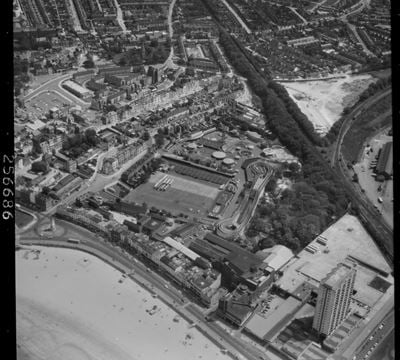
Margate
Dreamland amusement park, Margate, 1973
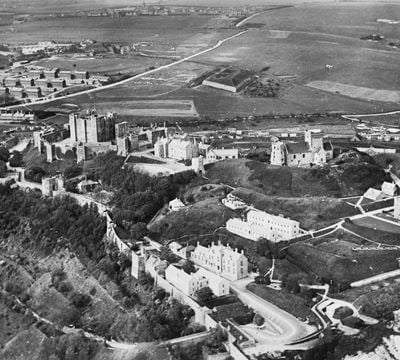
Dover
The castle, Dover, 1920

Dover
Dover Castle, Dover, 1949

Folkestone
Inner Harbour and Outer Harbour, Folkestone, 1920
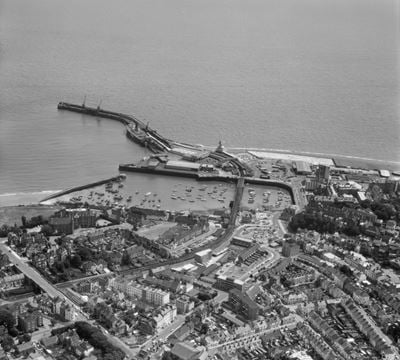
Folkestone
Town and harbour, Folkestone, 1976

Farningham
Fort Farningham, Farningham, 1948

Farningham
Fort Farningham, Farningham, 1948
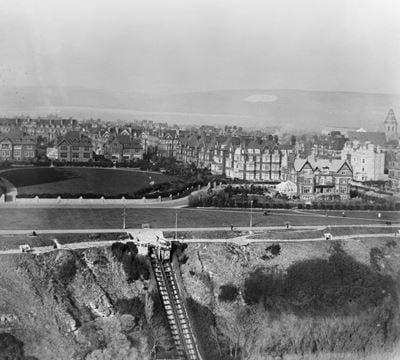
Folkestone
Cliff Railway, Folkestone, 1920
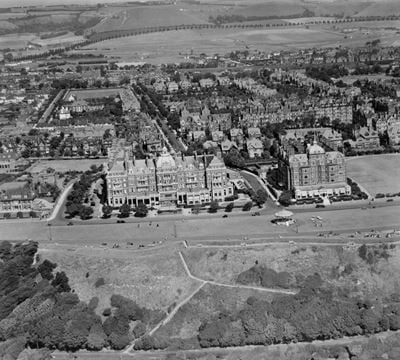
Folkestone
The Hotel Metropole, Grand Hotel and environs, Folkestone, 1933
Kent in the Historic England Archive
The Historic England Archive cares for over 15 million images, dating from the 1850s to the present day. Discover stunning images of Kent's past. Skip this section and go to stories about heritage
Charles George Harper Collection
Shepway, Kent
Date created: 1892 - 1933
A view from the west showing the tower of All Saints' Church
Eric de Mare
Ashford, Kent
Date created: 1945 - 1980
Exterior view of an unidentified two storey weatherboarded house in Rolvenden.
John Gay Collection: Modern Architects
West Cross, Ashford, Kent
Date created: 1971
An architects model of the proposed West Cross housing development in Tenterden
John Gay Collection: Rural Life
Ashford, Kent
Date created: Feb 1965
A sick calf inside a shed on a farm near Ashford
John Gay Collection: Miscellaneous
Kent
Date created: 1946 - 1959
View within a car showing a dog, probably called Baker White sitting in the drivers seat
John Gay Collection: Counties
Tunbridge Wells, Kent
Date created: 1950s
The monument to Sir Alexander Culpeper in St Mary's Church, Goudhurst, showing a stone relief, dated 1537, in the window jamb
John Laing Collection
Ashford, Kent
Date created: circa 1997
The station building at Ashford International Railway Station from the south, with a corner of the multi-storey car park in the foreground
London, Midland and Scottish Railway Company
Patrixbourne, Canterbury, Kent
Date created: 06 Jul 1909
The south side of St Mary's Church viewed from the road
Alfred Newton and Sons
Sandgate, Shepway, Kent
Date created: 1896 - 1920
GENERAL ELEVATED VIEW ACROSS TOWN ALONG COAST
Nigel Temple Collection of Postcards of Parks and Gardens
The Common, Royal Tunbridge Wells, Tunbridge Wells, Kent
Date created: 1900 - 1930
GENERAL VIEW OF PEOPLE ON THE COMMON OVERLOOKING THE TOWN
Walter Scott
Canterbury, Kent
Date created: 1920 - 1940
Exterior view showing a First World War tank in front of Canterbury Town Walls
Charles George Harper Collection
Tunbridge Wells, Kent
Date created: 1892 - 1933
Scotney Castle, seen from the south-west
Stories about heritage in your local area
Historic England publishes news, blogs, research, videos, and podcasts celebrating England's rich heritage. Discover the stories we have about Kent. Skip this section and go to education
A Brief Introduction to Semi-Detached Housing
Mentions Aucher Close
Semi-detached housing is the most prevalent type of housing in England today, making up one third of the housing stock.
What Is the Oldest Castle in England?
Mentions Dover Castle, Fortifications, Roman lighthouse and medieval chapel on Western Heights, Rochester Castle
Discover the oldest English castle contenders, including the Norman Berkhamsted Castle, Windsor Castle, Dover Castle and The White Tower, London.
The History of England’s Village Greens
Mentions Borstal Hill Windmill, Quintain
The origins of village greens in England date back to the early Middle Ages. Village greens are open spaces that can be registered.
Battles, Castles and Ships: England’s Military History from the Air
Mentions Artillery castle at Walmer
Discover England's military history through aerial photography from the Aerofilms Collection.
The Life and Work of John Smeaton, the ‘Father of Civil Engineering’
Mentions The Royal Harbour, Ramsgate
Discover the remarkable feats of engineering by British civil engineer John Smeaton.
The Rise and Fall of Anne Boleyn in 12 Historic Places
Mentions Hever Castle
Discover the locations where Anne Boleyn lived, including Hever Castle, the Tower of London, and Hampton Court Palace.
16 Historic Gardens and Landscapes to Visit
Mentions Walmer Castle
Try these English gardens if you’re looking for somewhere with spectacular garden scenery.
What Is the Oldest Building in England?
Mentions Church of St Martin, The Roman Pharos, Church of St Mary Sub-castro
From the oldest church to archaeological remains, here are the contenders for England's oldest building.
10 Historic Sites to See in Margate
Mentions Dreamland Cinema, The Scenic Railway at Dreamland, The Grotto
Check out these must-see historic sites when visiting this famous Kent seaside town.
What Are Hulks?
Mentions Wreck of Old Brig
Discover some of the abandoned ships that line England’s coast and rivers.
12 Things to Know About the ‘Austerity Games’: The 1948 London Olympics
Mentions Finnish Olympic Sauna
Find out more about the cash-strapped London Olympic Games of 1948.
5 Things to Know About Coronations
Mentions Christchurch Cathedral
Discover the history and heritage behind the ancient English coronation ceremony.
Mentions Kent
The Rooswijk was a Dutch East India Company trading ship that sunk in January 1740 on the Goodwin Sands off the Kent coast.
What We Found on a 1740 Shipwreck: Sabres, Silver and Secrets From the Deep
The Rooswijk was a Dutch East India Company trading ship that sunk in January 1740 on the Goodwin Sands off the Kent coast.
Mentions Kent
Chatham Intra is the name given to an area adjoining the River Medway that links the historic settlements of Chatham and Rochester in Kent.
Between Chatham and Rochester: The Old Intra High Street
Chatham Intra is the name given to an area adjoining the River Medway that links the historic settlements of Chatham and Rochester in Kent. The area was largely undeveloped until the early 17th century before becoming built up with a mixture of commercial, industrial and residential buildings.
Rooswijk Shipwreck Excavation The Post Excavation Phase
Mentions Kent
Find out how a team of specialists is researching and conserving the artefacts from the 18th-century shipwreck of the Rooswijk.
Making Waves: Selected Updates from the Rooswijk Project
Mentions Kent
Updates on the conservation and investigation of finds from the Rooswijk shipwreck.
Research Reports Roundup February 2025
Mentions Kent
A roundup of the latest additions to our research reports database from October 2024 to February 2025, arranged by theme.
England's Suburbs 1820-2020
Mentions Kent
Historic England’s major national research project on the heritage of suburbs reaches its conclusion.
30 New Projects Explore England’s Rural and CoastalWorking-Class Heritage
Mentions Kent
Funded by Historic England's Everyday Heritage grants programme, these projects will explore untold stories and celebrate the heart of our history.
50 Years of Flying for Heritage
Mentions Kent
Learn about discoveries made in over 50 years of flying by Historic England aerial photographers and their predecessors.
Roman Richborough
Mentions Kent
Recent work allows a new plan or Richborough Roman fort to be presented and contributes to understanding a site of international importance.
Coinage and Ritual Deposition at Stanwick, Northamptonshire.
Mentions Kent
Analysis of one of the largest rural coin assemblages from Roman Britain at Stanwick, Northamptonshire sheds light on Roman ritual and economy.
The Roman Landscape Characterisation and Prediction Project
Mentions Lullingstone Roman villa and Saxon church, Kent
Harnessing the potential of existing knowledge to develop predictive models of Roman settlement.
Unusual Bridge Across the Basingstoke Canal Listed
Mentions Kent
The Inglis Pyramid Bridge near Aldershot is a rare survivor of a type of First World War portable military bridge.
Shipwreck Linked To Wordsworth Family Granted Protection
Mentions Kent
The wreck of the Earl of Abergavenny has been scheduled by DCMS on the advice of Historic England.
Margate's 1930s Former Tidal Swimming Pool Listed
Mentions Marine Terrace Tidal Pool, Walpole Bay Tidal Pool, Nayland Rock promenade shelter
The former tidal pool at the west end of Margate Main Sands in Kent has been Grade II listed on the advice of Historic England.
Kent's social history through photos
Over 10,000 images from the Historic England Archive have been specially selected and re-captioned for teachers, students, and anyone who wants to learn more about their local area. Skip this section and go to grant-aided places
Yew trees, Scotton Street, Wye, Kent
Period: Tudor (1485 - 1602)
A high status timber framed house dating from 1605 amazingly well preserved with original windows.
Yew trees, Scotton Street, Wye, Kent
Ye Olde Grocery Stores, 98 Middle Street, Deal, Kent
Period: Georgian (1714 - 1836)
A view showing the shop front and rounded corner window above.
Ye Olde Grocery Stores, 98 Middle Street, Deal, Kent
Working with hop bines
Period: 1970s (1970 - 1979)
Unloading hop bines under a metal canopy in Kent.
Working with hop bines
Working with hop bines
Period: 1970s (1970 - 1979)
Unloading hop bines under a metal canopy in Kent.
Working with hop bines
Whitstable Harbour, Whitstable, Kent
Period: Victorian (1837 - 1901)
The harbour at Whitstable opened in circa 1832 and can be seen here with large sailing vessels moored by the harbour walls.
Westgate, Canterbury, Kent
Period: Medieval (Middle Ages) (1066 - 1484)
The Westgate was originally one of seven gates to the city of Canterbury.
Westgate, Canterbury, Kent
Westgate, Canterbury, Kent
Period: 1960s (1960 - 1969)
A view of the Westgate which spans across London Road. The gate was built by Archbishop Sudbury in circa 1380.
Westgate, Canterbury, Kent
Waterworks, High Street, Leigh, Kent
Period: Victorian (1837 - 1901)
A waterworks built in the 1870s. There are 2 octagonal buildings with octagonal cupolas.
Waterworks, High Street, Leigh, Kent
Tags
Visit grant-aided places near you
These places and buildings have been helped by Historic England's financial grants. Find historic places in your neighbourhood that you never knew existed! Please note that opening times may vary. Skip this section and go to related locations
Church of St John the Divine, 10 Railway Street
Built in 1821 under the Church Building Act of 1818, St. George's Church in Chatham is a Commissioners church in a neoclassical Doric style.
Sheerness Dockyard Church, Sheerness
Dockyard Church will open to the public in April 2023, serving as a business center for young people.
Discover more
Ready for more local heritage? Take a look at these other places nearby


